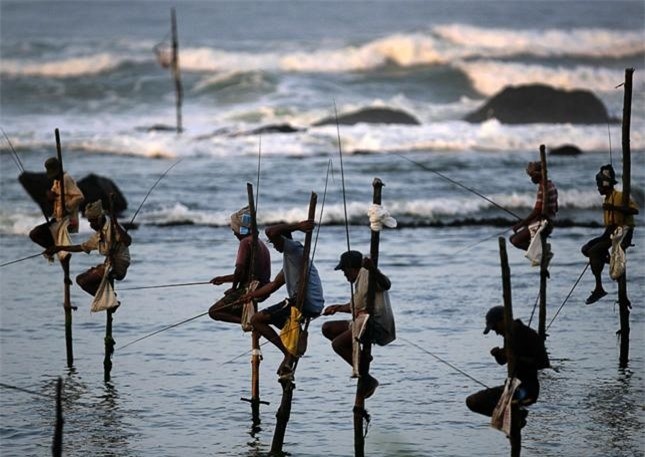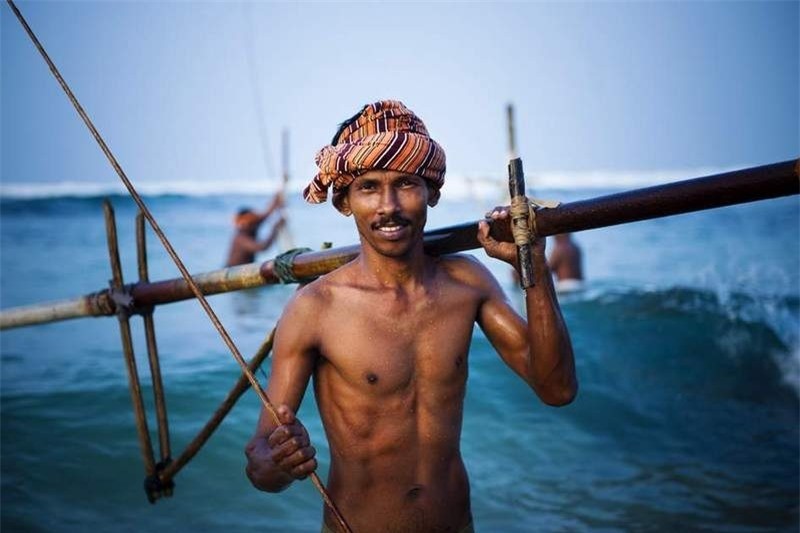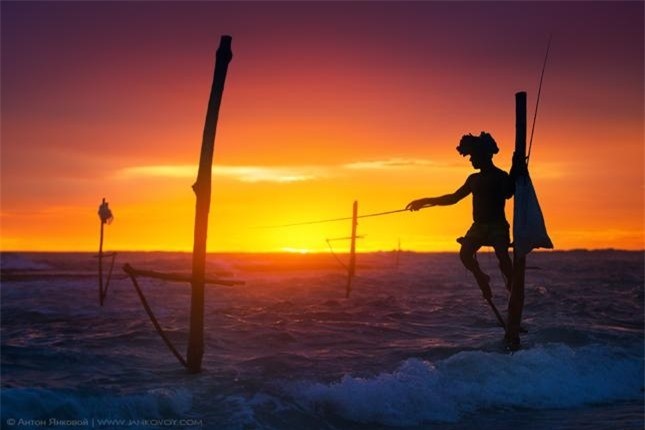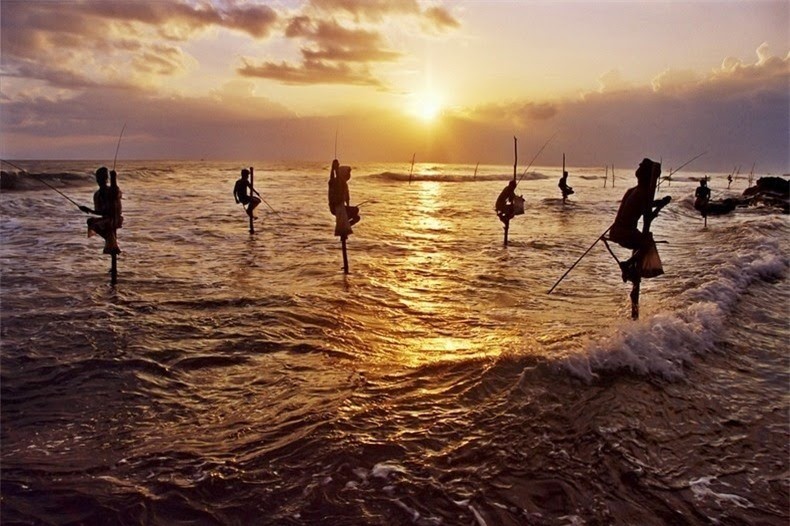The Last Stilt Fishermen in Sri Lanka
 |
| Stilt fishing practice, or Ritipanna in Sinhalese. Photo: Doanhnghiepvn |
Stilt fishing practice, or Ritipanna in Sinhalese, is a popular tourist attraction in Sri Lanka where you can take breathtaking photographs of the fishermen silhouetted against the horizon at dawn and dusk.
What is stilt fishing?
The origin of stilt fishing started in the 18th century, some villagers cannot afford buying fishing boats. Some said the practice might have started during World War II when food shortages and overcrowded fishing spots prompted some clever men to try fishing on the water.
This fishing technique requires simple equipments and is much more environmental-friendly than net fishing. This is partially why many believed that stilt fishing was created for environment purposes. A fishing rod, a angled, and a stilt are used for fishing. Kitul wood is used to make bait sticks.
 |
| Stilt fishing technique is passed down from fathers to sons for generations. Photo:Doanhnghiepvn |
First, the branches of the Kitul tree are broken off and dried in the sun. It is then heated over a fire and the rod is bent. Sturdy thread is used for the rope attached to the Kitul stick, which is up to 2 m in length. The shell of cutlet-fish is used as a mold to make the bait.
The mold is then made from the billet shell, and the molten white lead liquid is poured into the mold. About 5 minutes after the end of the process, the bait shell can be removed from the mold. The special thing here is not to use bait and they only use lead angled for stilt fishing.
Alastonian wood, reed pines and even galvanized wood stilt can also be used depends on the available resources.
The most difficult task is to find shallow spot to put the stilt. Fishermen planted the sharply pointed ridges 5 - 8 cm depth. The fisherman then stands on the cross while fishing.
The crossbar allows the fishermen to be seated a couple of meters above the water causing minimal shadows on the water and hence little to no disturbance amongst the sea life. The stilt fishermen then use a rod from this precarious position to bring in a good catch of spotted herrings and small mackerels from the comparative shallows of the sea or from the river. They collect the catch in a bag tied to the pole or to their waist.
You might find the skilled stilt-fishing artists at Mirissa beach, Hikkaduwa beach, and Unawatuna Beach. Now that there are fewer and fewer stilt fishermen, it is a rare opportunity to learn about this special technique.
Why are there no more true stilt fishermen?
 |
| Breathtaking view of stilt fisherman at the horizon. Photo: Doanhnghiep vn |
Stilt Fishing is one of the most interesting traditional fishing methods of Sri Lanka. The iconic images of fisherman perched on wooden stilts used to be seen all along the southern coast.
Often sitting for hours at a time – one hand holding the stilt, the other holding the rod – the fisherman’s work is a remarkable act of patience, skill, balance and endurance. The tradition is passed on from fathers to sons. Each year, however, fewer and fewer families practice the craft.
This fishing method was more widely used all along the coast until the tsunami in 2004 which caused such activities to cease significantly over the years.
The beautiful sight of fishermen perched branched poles as they fish skillfully during dawn, noon and dusk; can now be commonly along the southern coast in towns such as Koggala, Kaththaluwa and Ahangama. They often find fish species such as Indian mackerel, tuna, bigeye scad, herring and goldstripe sardinella. Fish are most active at the beginning of the southwest monsoon season (May / June).
 |
| Fishermen wait for hours to catch fish. Photo: Doanhnghiepvn |
Occasional stilt fishermen can also be seen amongst the waters of Madu River.
True fishermen on the stilts are few and far between. Most are imposters profiting from tourists. Many of the true stilt fisherman have taken up farming, or reselling fish purchased at larger markets. A few still fish, but from further out at sea.
Sri Lankan stilt fishing continues as a major tourist attraction. Often fishermen earn some money by appearing in their photos when a foreign tourist group arrives. Also, foreign tourists are seen on the country holding bait and posing for photographs, giving more money to the fishermen. Tourism has been a major source of income for stilt fishermen.
 | Discover Beautiful Nepal In The Autumn Time November is a perfect time to visit Nepal, one of the most attractive destinations in the world. Thousands of people come here each year to ... |
 | Top 5 Nature Camping Sites in Da Lat Many campers seek adventure in the charming forests of Da Lat. Learn more about these fantastic nature spots. |
 | Sigiriya Rock Fortress: The Acient Masterpiece of Sri Lanka Lying deep in the forest, there is an ancient rock fortress with century-old history, and is also a famous place for archaeological research, tourism and ... |
Recommended
 World
World
India strikes back at terrorists with Operation Sindoor
 World
World
India sending Holy Relics of Lord Buddha to Vietnam a special gesture, has generated tremendous spiritual faith: Kiren Rijiju
 World
World
Why the India-US Sonobuoy Co-Production Agreement Matters
 World
World
Vietnam’s 50-year Reunification Celebration Garners Argentine Press’s Attention
Popular article
 World
World
"Will continue offering our full support to Indian govt": US FBI Director after Pahalgam attack
 World
World
"Great Leader": JD Vance Lauds PM Modi During His India Visit
 World
World
Trump’s Tariff Pause: A Strategic Move from “The Art of the Deal”?
 World
World







